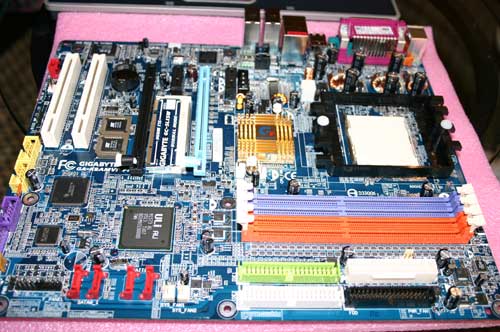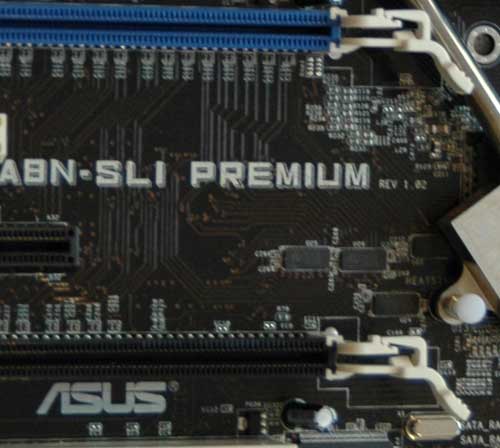ATI's Multi-GPU Solution: CrossFire
by Anand Lal Shimpi & Derek Wilson on May 30, 2005 9:00 PM EST- Posted in
- GPUs
What Happened to the Selector Card?
One of ATI's most interesting claims with their CrossFire solution is that you no longer need the selector card that is seen on nForce4 SLI motherboards. How is it that ATI is able to get around this requirement? Contrary to popular belief, it's not magic.By default, the nForce4 SLI chipset sends all 16 PCI Express lanes from the North Bridge to the first PCI Express x16 slot on a nForce4 SLI motherboard.
Flipping the selector card the other way divides the PCI Express lanes and sends the first 8 lanes to the first slot and the remaining 8 lanes to the second slot.
ATI's MVP chipset works slightly differently; by default, the North Bridge sends 8 PCI Express lanes to each of the two PCI Express slots. If you have two cards installed, then this is the desired configuration. However, if you only have one card installed, in order to get a full PCI Express x16 slot, one of the following methods must be implemented by the motherboard manufacturer:
Option 1 - Terminator Card
The first option is a terminator card that is installed into the second PCI Express x16 slot. This card simply reroutes the 8 PCI Express lanes going into the slot back to the first PCI Express slot, giving it all 16 PCI Express lanes.

Obviously, the downside to this approach is that you have to use a terminator card; we haven't heard of many manufacturers doing this.
Option 2 - SLI Selector Card
The second option is to implement the same selector card that is used in nForce4 SLI motherboards. If you want a single x16 slot, flip the card one way. If you want two x8 slots, just change its orientation and you are good to go.

The obvious downside here is that the user has to play with the selector card, something that ATI wants to avoid. Despite ATI's desire to avoid this card, some manufacturers are implementing it:

Option 3 - Selector ICs
The third (and most expensive) option is for the motherboard manufacturer to place a series of selector ICs (Integrated Circuits) on the motherboard itself, which will allow for the user to switch between one x16 slot or two x8 slots from within the BIOS. This is the most desired implementation from the end user's standpoint, but it is the most expensive option.
Either 4 or 5 chips have to be placed on the motherboard in order to allow for this software-selection of PCI Express configuration. Each chip costs the motherboard manufacturer approximately $1, which isn't really a problem for high end motherboards.

Note that there is also no reason why the same technology can't be implemented on nForce4 SLI motherboards; in fact, ASUS has already implemented it on their latest nForce4 SLI solution:











57 Comments
View All Comments
Bloodshedder - Monday, May 30, 2005 - link
Kind of makes me wonder about compatibility with All-in-Wonder cards.RadeonGuy - Monday, May 30, 2005 - link
why didnt you run it on a FX-55 and 1gig of memoryQuintin - Monday, May 30, 2005 - link
interesting....ksherman - Monday, May 30, 2005 - link
#6, Id love too, but I dont have the money right now and the cards are not availible...Brian23 - Monday, May 30, 2005 - link
#9, #10, and #11: That will never happen. The traces between the GPU and the memory need to be UBER short. The socket would increase trace lengths too much. Plus there is so many kinds of graphics memory with different bus widths.Waylay00 - Monday, May 30, 2005 - link
What would be better is a motherboard that has a built in GPU socket and you could buy the GPU's just like CPU's. Then there would be no need for video cards, but rather just video RAM and the GPU core.Waylay00 - Monday, May 30, 2005 - link
UNCjigga - Monday, May 30, 2005 - link
What I really want is a graphics card with extra sockets for a 2nd GPU and more RAM. So I can start with one board with a single GPU and 256MB RAM, then I can upgrade either the existing GPU with a faster one, and/or upgrade the RAM from 256MB to 512MB, and/or slap a second GPU into the extra socket and effectively double performance. That would rock.arfan - Monday, May 30, 2005 - link
Good Job ATIbob661 - Monday, May 30, 2005 - link
I wonder what the REAL price will be on the Crossfire cards.